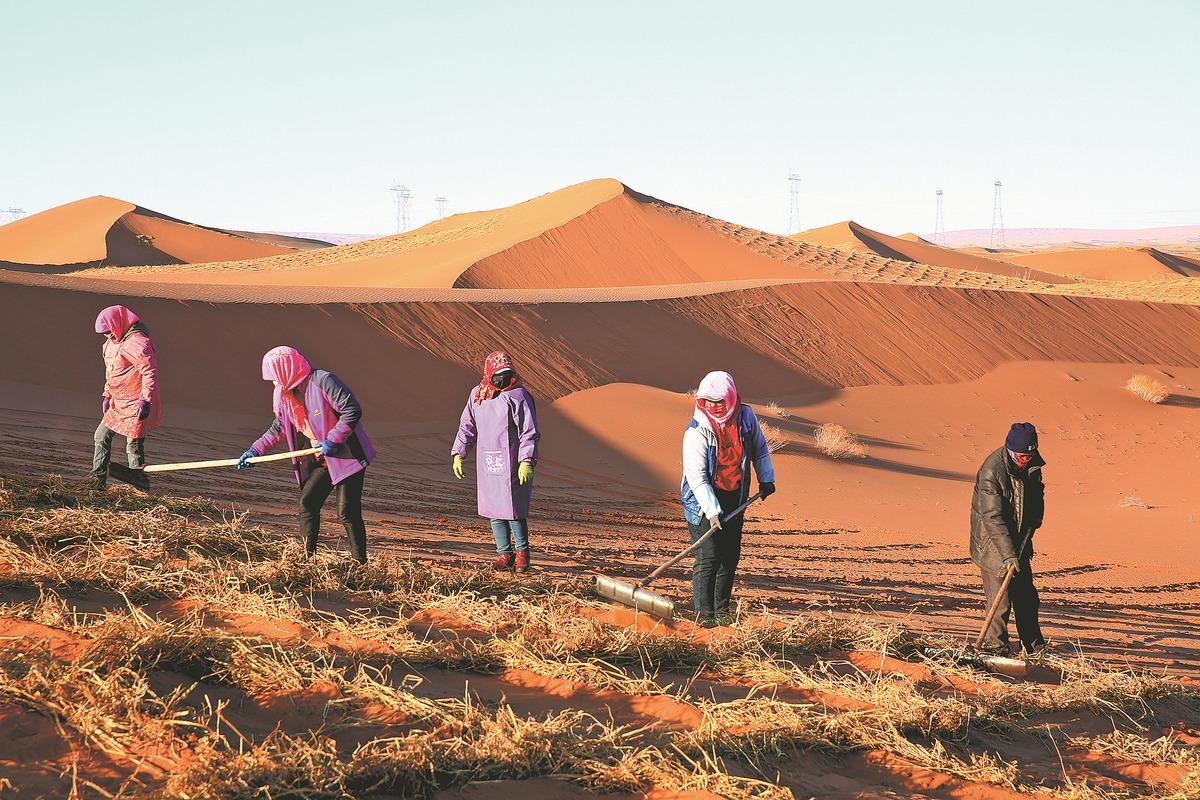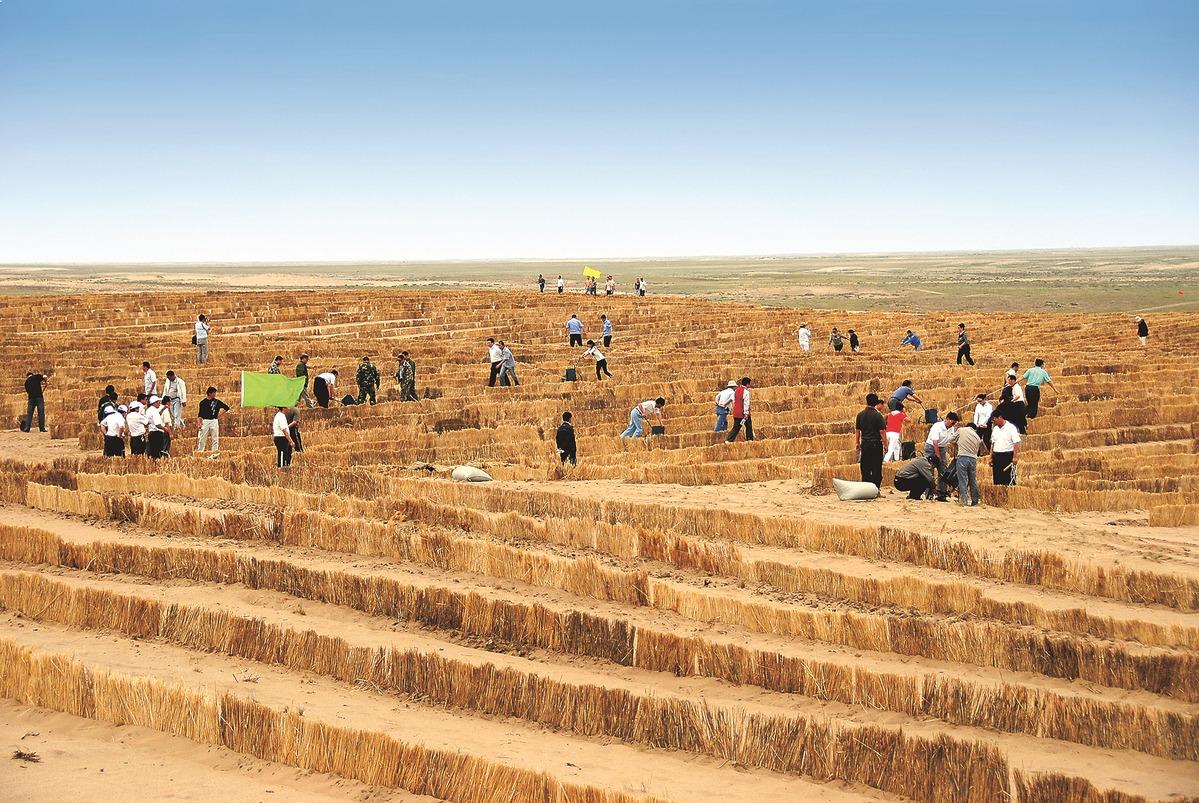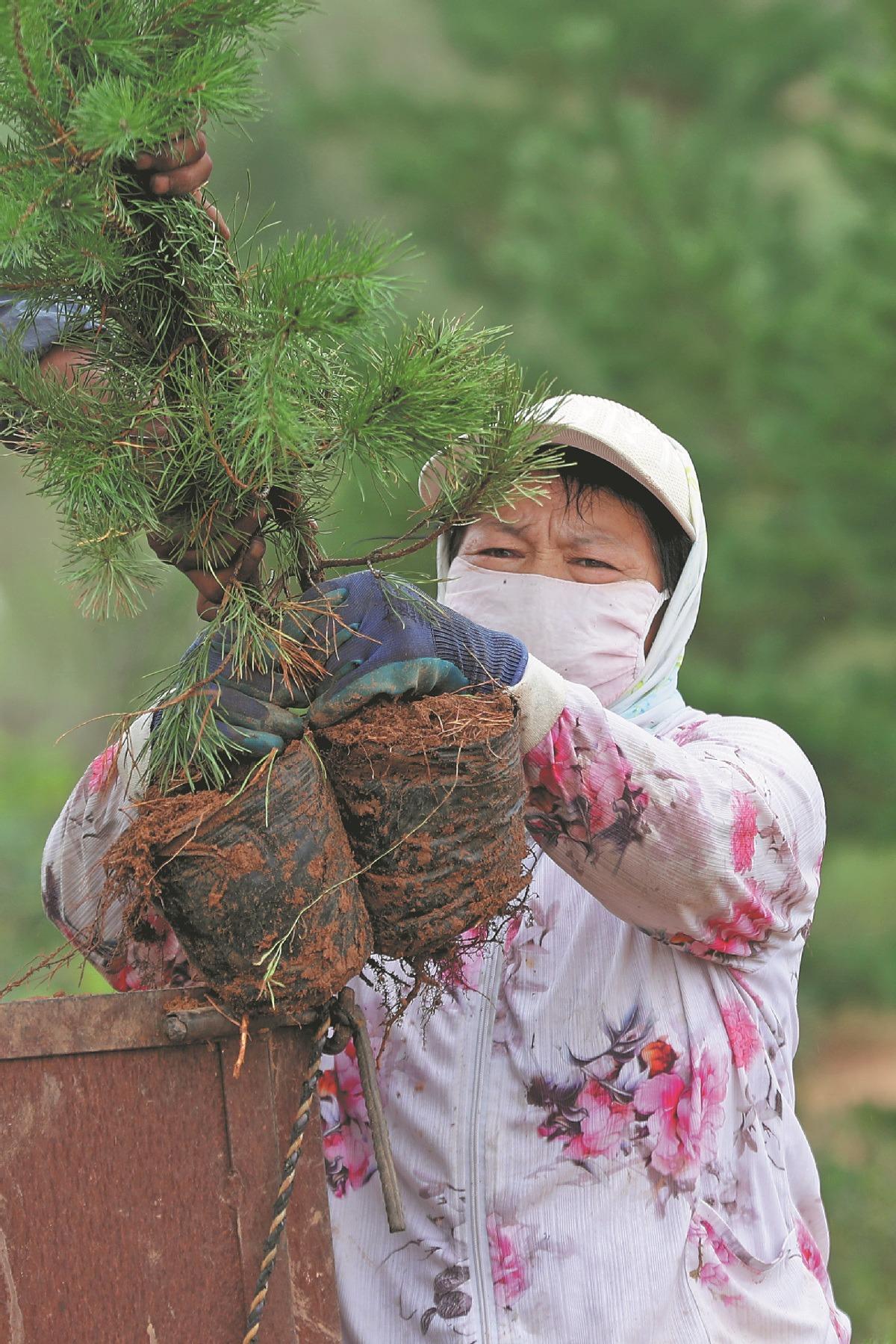Editor's note: As protection of the planet's flora, fauna and resources becomes increasingly important, China Daily is publishing a series of stories to illustrate the country's commitment to safeguarding the natural world.
 Sandcontrol workers help prepare barriers that will house sand-resistant plants in Gansu province. (YANG YONGWEI / FOR CHINA DAILY)
Sandcontrol workers help prepare barriers that will house sand-resistant plants in Gansu province. (YANG YONGWEI / FOR CHINA DAILY)
Mass public participation in afforestation efforts takes root. Zheng Jinran and Yuan Hui report from Chifeng, Inner Mongolia autonomous region.
In the Tengger Desert last month, yellow sand danced on the breeze and a profusion of sweetvetch swung its green leaves.
"In summer, you can see an amazing flower ocean when the plants bloom with their small pink, yellow or purplish petals," said Liang Cunxin, from Alshaa Left Banner, Inner Mongolia autonomous region.
"The enduring vitality of such plants on the barren land is astonishing," said the 53-year-old, whose family lived in the area for decades but was forced to relocate in 2007 as a result of desert encroachment.
"The government encouraged us to plant saxaul and little-leaf pea shrubs, which are commonly used to fix dunes in deserts, but the survival rate was unsatisfactory so we switched to this plant, and it has worked," he said.
The Tengger covers about 43,000 square kilometers in Inner Mongolia and Gansu province, making it China's fourth-largest arid area.
More than 2 million sweetvetch shrubs have been planted since 2017, and the hardy perennial has gradually covered more than 33 sq km of desert, Liang added.
Like Liang's family and their peers, about 400 million people from 30 provinces and regions have been affected by desertification, which by 2019 had covered a combined area of 1.68 million sq km, or 17.58 percent of China's total land area, according to data from the National Forestry and Grassland Administration.
 A farmer plows land ready for sweetvetch shrubs to be planted in the Tengger Desert, Inner Mongolia autonomous region. (SURINA / FOR CHINA DAILY)
A farmer plows land ready for sweetvetch shrubs to be planted in the Tengger Desert, Inner Mongolia autonomous region. (SURINA / FOR CHINA DAILY)
Essential tasks
Speaking on Tuesday during a meeting with officials after a fact-finding trip to Inner Mongolia's Bayannuur, President Xi Jinping said the strengthening of efforts to fight desertification and move forward with key projects, such as the Three-North Shelter Forest Program, is related to China's environmental security, the building of a strong nation and the sustained development of the Chinese nation.
Xi called for sustained efforts to create new miracles in tackling desertification. He reiterated the need to adopt a holistic approach to conserving mountains, rivers, forests, farmland, lakes, grassland and deserts, and to prioritize the prevention and control of desertification as part of broader steps to build up a shield for environmental security in northern China.
ALSO READ: Xi calls for sustained efforts in curbing desertification
Sun Tao, director of the desertification monitoring center with the Forestry Survey and Planning Institute at the NFGA, said, "China has made tremendous anti-desertification efforts, especially in the vast northern and northwestern regions, as the arid land in these areas has been a major source of sandstorms. Severe sandstorms can affect even large regions and their populations."
A series of storms from March 19 to 22 swept across 3.62 million sq km and affected 560 million people, the administration said.
Sun noted that the storms, with sand mainly originating in Mongolia and the Xinjiang Uygur autonomous region, were divided into three routes — eastern, middle and western — mainly based on their origins and main routes. He added that Beijing is usually affected by those in the eastern and middle routes.
Eight rounds of sandstorms were recorded in March and April, Sun said, adding that five were in the eastern and middle routes.
"Sandstorms occur when all three required factors are present: sources of sand; volatile air conditions; and winds," he said, noting that sand and dust is lifted into the air and carried long distances by strong winds.
"The only factors that we, as humans, can affect are the sources of sand, thus making desertification-control measures important to controlling storms," he said.
 Volunteers take part in an anti-desertification activity in Hulunbuir, Inner Mongolia. (PHOTO / CHINA DAILY)
Volunteers take part in an anti-desertification activity in Hulunbuir, Inner Mongolia. (PHOTO / CHINA DAILY)
Global issue
The fight against desertification has become a global issue, making international cooperation essential. As such, Chinese methods could be shared with countries facing similar problems, Sun said.
Lying to the north, the Gobi Desert region of Mongolia, especially the part that borders China, has become a major source of dust and sand.
During March and April, the area accounted for more than 42 percent of the dust and sand concentrations across northern China, according to recent research conducted by Huang Jianping, an academician at the Chinese Academy of Sciences and a professor at Lanzhou University.
Huang's work also showed that Xinjiang's Taklimakan — China's largest desert — accounted for 26 percent of airborne sand during the same two months.
Sun said China and Mongolia have discussed establishing a joint center to control and prevent desertification, adding that China and a number of Arab nations also plan to found a research center on drought, desertification and land degradation.
"But more importantly, we need to do our greening efforts well, which could effectively mitigate the impact of sand and dust storms," he said.
President Xi has also called for extensive international exchanges and cooperation in fulfilling China's commitments to the United Nations Convention to Combat Desertification. China will actively participate in global anti-desertification and environmental governance efforts, strengthen cooperation with neighboring countries and support desertification-control initiatives under the Belt and Road Initiative, he said.
Systematic measures
At least 30 herding households are helping Liang Cunxin plant sweetvetch in the Tengger. They plan to cover about 66 sq km in the next three years, doubling the area currently under cultivation.
They are part of mass public participation in regional afforestation efforts to extend the vegetation cover.
Their home, Inner Mongolia, accounts for 23.7 percent of the national area of desertified land, making it one of China's most badly affected regions. As such, it has implemented significant measures, especially afforestation efforts.
"We have expanded forest coverage by over 6,666 sq km annually, and grassland by over 20,000 sq km," said Ma Qiang, deputy head of the regional forestry and grassland administration, adding that more than 2 billion trees have been planted via voluntary public afforestation initiatives. He noted that the efforts have seen the area of desertified land in the region fall for 15 consecutive years.
ALSO READ: Joint fight against desertification
According to the regional forestry authority, along with extensive afforestation efforts, Inner Mongolia has implemented such measures as strict grazing controls and grassland conservation projects, explored new techniques, and established policies and regulations to guide sustainable land management practices. The measures are part of broader national initiatives to combat desertification and restore degraded ecosystems.
Moreover, China has taken a systematic and scientific approach to combating desertification in recent decades, encompassing mountains, bodies of water, forests, farmland, lakes, grassland and deserts. As one of the leading guidelines, the National Desertification Prevention and Control Plan (2021-30), lists coordinated measures among different regions, based on their situations, and outlines measures to reach various targets.
More than 6.67 million hectares of desertified land will be treated by 2025, rising to over 12.4 million hectares by 2030, according to the plan.
"Specific projects are being implemented, such as the Three-North Shelter Forest Program, protection and restoration of natural forests, control of sources of sand and dust storms in the Beijing-Tianjin region, and environmental restoration in mining areas. The goals are to improve ecosystem stability and mitigate desertification," said Sun, from the National Forestry and Grassland Administration's desertification monitoring center.
President Xi has set a goal of developing the Three-North program — launched in 1978 to retard expansion of the Gobi Desert — into an unbreakable "Great Green Wall" within 10 years. He highlighted 2021-30, the project's sixth phase, as the key period for consolidation and expanding achievements.
 A resident plants Scots pine saplings in the Mu Us Desert in Shenmu city, Shanxi province. (JIANG QIMING / CHINA NEWS SERVICE)
A resident plants Scots pine saplings in the Mu Us Desert in Shenmu city, Shanxi province. (JIANG QIMING / CHINA NEWS SERVICE)
Innovative participation
Anti-desertification measures allow communities to enjoy better living conditions and more sustainable socioeconomic growth, which encourages greater participation from people in affected areas.
For example, the Three-North program, which extends across China's northwestern, northern and northeastern regions, helped lift 15 million rural residents out of poverty by the end of 2020, data from the National Forestry and Grassland Administration show.
Regions involved with the program have received around 385 million visits every year, with annual direct tourism revenue reaching 48 billion yuan ($6.7 billion), it added.
In addition to the traditional revenue generated by the agricultural and tourism service sectors, residents enjoy extra benefits.
At the Qiansongba Forest Farm in Chengde, Hebei province, the carbon credits from its carbon sink forest — used to offset emissions of greenhouse gases — generated more than 3.59 million yuan from December 2014 to April 2020, said Ma Shuen, an engineer with the farm.
"The villagers were surprised to receive extra money (as government subsidies), so more people were motivated to apply for their own planted areas to become carbon sink forests," he said. Ma added that the price of carbon credits may rise because of the government support, so he's confident that people will continue to plant trees.
Meanwhile, Ant Forest, an app developed by Ant Group, allows users to earn virtual "green energy" points through eco-friendly behaviors, such as walking instead of driving and by using public transportation.
ALSO READ: Pushing back desertification
Users can convert points into trees planted in designated areas, track the progress of planting and the effect of their contribution.
So far, it has attracted over 650 million users, the group's data show.
"I want to accumulate points, which encourages me to adopt a green, healthy life — like walking or riding bicycles — and I urge my friends to join in. So far, I have planted over 2,000 trees via Ant Forest," said Liu Shuangming, who works in the construction industry.
He said the innovative approach provides him with a tangible way to contribute to reforestation efforts.
"Now, I know more about how individuals can help protect the environment, and it's amazing to track my trees," he said.
Liang Zheng, head of the sustainable public welfare department at Ant Group, said that more than 400 million trees have been planted since 2016, half of them in Inner Mongolia.
"The project will invest 100 billion yuan to support pilot projects at the Hunshandake Forest Farm over the next three years," she said.
Rising awareness
Xie Mingyu, head of the Hunshandake Forest Farm in Inner Mongolia, praised such active participation, saying rising awareness of environmental protection and diverse participation helps promote the projects.
Liang Cunxin, the farmer who grows sweetvetch, gained the nickname Uncle Sweetvetch after showing off his flowers in the desert via online videos and receiving tens of thousands of likes.
"People are welcome to view the flower ocean in the desert and enjoy this miracle," he said with a big smile.


